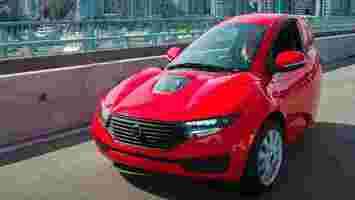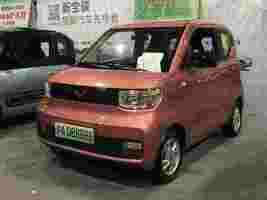3 wheels, 1 seat: A closer look at Electrameccanica’s 2021 Solo EV
This article was originally published by John Faulkner on Clean Fleet Report , a publication that gives its readers the information they need to move to cars and trucks with best fuel economy, including electric cars, fuel cells, plug-in hybrids, hybrids, and advanced diesel and gasoline engines.

Three-wheel electric vehicle for one
Perception is everything.
Solo is the vehicle’s name, and for good reason. It seats one person. Sound restrictive or limited? It all depends.
Coming to grips with a single-seat vehicle
This is the elevator pitch from ElectraMeccanica about owning a Solo EV.
“Every day, 119 million North Americans commute using personal vehicles— and 105 million of them commute alone. Step into the future of driving. Reduce your gas bill to zero. Eliminate your environmental impact. Turn your commute into the highlight of your day.”
Except for the last line, they are on to something here. Look around next time you are stuck in Traffic from Hell freeway jam, and you will inevitably see car after car with only the driver. How about those 8,000-to-10,000-pound SUVs and pickups carrying only one 150-pound person? Salient points. Then there is the no fuel expense and minimal maintenance, and this is looking even more appealing. So, where would a challenge lie for the Solo EV?
Perception 1: Size. When I showed several friends photos of the Solo, to a person, they said it is too small for them. When told it can hold a 6-foot, 200-pound person, they shrugged, then said it is too small to be safe.
Driving a solo EV
Until Clean Fleet Report has the Solo for several days, we can only report on our drive around a coned course in a parking lot. Acceleration and braking were the key points we were looking for, as good handling for a three-wheeler will never be a concern. The acceleration was peppy, but not fast, and the braking was solid, but not short. The motor is loud at slow speeds, which we suspect becomes unnoticeable at freeway speeds. What we have here is a capable freeway runner and an around-town bebopper that will go up-to 100 miles on a charge with a top speed of 80 mph.
The specs illustrate how simple and uncomplicated the Solo is compared to other vehicles.
53 horsepower liquid-cooled motor
94 foot-pounds of torque
17.3 kilowatt-hour NCA (lithium nickel cobalt aluminum oxides) liquid-cooled battery
220V (level 2): 2.5 hours for up to 90% charge
110V (level 1): 8 hours for up to 60% charge
Power disc brakes
Electric power steering
1,710-pound curb weight
10’ 6” length
57.5” width–at the front wheels
53” height
This all-new, fully electric vehicle from ElectraMeccanica has two responsive front, 15-inch steer wheels shod with 135/70 tires, making the Solo easy to maneuver. Visibility was excellent and, as expected, all gauges and controls are within easy reach.
Solo EV features
Perception 2: Value. My friends assumed a vehicle this small was bare bones, equipped with few convenience features. Giving them the benefit of the doubt, I nodded, then gave them this list, which drew their approval.
Remote keyless entry
Power windows
Power mirrors
AM/FM/Bluetooth/USB
LCD digital instrument cluster
Four-way adjustable seat
Rear view camera
Carpeted rear storage compartment (trunk)
Cargo space=Five cubic feet
Heater, defogger and ventilation System
Air conditioning
LED headlamps
Dual outside heated mirrors
Intermittent wipers
Electric parking brake
Solo EV models
The consumer model of the Solo EV is a single-seat vehicle with a small cargo compartment behind the driver. The line is being expanded to include two versions, offering versatility for commercial and fleet uses, both equipped with a larger cargo box with either rear or side access. Think delivery services for pizza, groceries and prescriptions. Maybe even the last mile for mail and packages. The delivery possibilities are compelling. There are even plans to develop a sports car variant and a two-seat version.
ElectraMeccanica, a Canadian company, has a Chinese strategic manufacturing and investor partner, the Zongshen Industrial Group . An American assembly plant is planned to be built in either Nashville or Phoenix. Online reservations are currently being taken, similar to the early Tesla model, with a $250 deposit. Dealerships are either open or being set up in mall locations in California, Oregon, and Arizona. These manned retail sites do not require a large real estate footprint and are in the flow of consumers.
Solo EV pricing, warranty, and safety
The Solo EV has a MSRP of $18,500, but being classified as a motorcycle works for and against it. The good is it can be driven in the HOV lane without a sticker. The sort of good, but could be better news, is the Solo, as a motorcycle, does not qualify for the federal $7,500 tax credit or California’s $2,000 EV rebate. But in California it is eligible for a $750 rebate that goes to electric motorcycles. So, it is important to check with your state to see what programs apply to the purchase of a Solo EV.
Safety features include a chassis made of Teklam (a lightweight aerospace material), front and rear crumple zones, side impact protection and a roll bar. The Solo has doors on both sides that aid in access for everyday use, and in the case of an emergency. Being classified as a motorcycle, the Solo won’t be crash-tested by the US Government’s National Highway Traffic Safety Administration (NHTSA) or the non-profit Insurance Institute for Highway Safety (IIHS).
The Solo EV offers bumper-to-bumper warranties for two years, and five years on the battery.
Observations: 2021 ElectraMeccanica Solo EV
Paul Rivera, ElectraMeccanica’s CEO is an enthusiastic believer in the Solo EV, an enthusiasm which seems to run far deeper than just a paycheck for him. His passion for how this small, single-seat all-electric, three-wheeler will make a difference on society is infectious. The Solo EV Clean Fleet Report drove was designed for the American market, but for Rivera, that is only the beginning.
He said development is currently underway for a world Solo EV that will be targeted for countries where traffic congestion is bad, such as India, and cities where inner city vehicle use is restricted to electric vehicles. Rivera is looking to “the UK and Germany where they are further ahead on their electrified agenda, parking is at a premium, their sharing is more, and they have congestion taxes. In London, Paris, Gothenburg, and Stockholm, it makes a lot of sense.”
Other manufacturers have tried getting market share in America with small electric vehicles that cost twice as much as the Solo EV, but with little success. Both the Mercedes-Benz Smart , which has two seats, and the Fiat 500e , which can seat four, are no longer being sold on this side of the Atlantic. So, maybe the lower cost of ownership will be the difference maker for ElectraMeccanica, where they make the case for the Solo EV as an efficient, practical transportation alternative for an urban setting.
Another factor is pre-owned EVs that are less than three years old, are still on their original warranties, have seating for four and larger cargo areas. These are readily available for $15,000 to $17,000. Personal note: A family member recently purchased a 2019 Volkswagen E-Golf SE with 17,000 miles on it for $15,500. Considering one year ago this car sold for $33,500, you can see where pre-owned EV pricing will be a challenge to the Solo EV. We explored that market recently.
All of this certainly does not mean the Solo EV can’t find and fill a niche where the others could not. If Paul Riviera has anything to say about it, it will. Don’t bet against them.
You can follow Clean Fleet Report on Twitter and Facebook .
SHIFT is brought to you by Polestar. It’s time to accelerate the shift to sustainable mobility. That is why Polestar combines electric driving with cutting-edge design and thrilling performance. Find out how .
Who’s to blame for self-driving vehicle accidents? UK says it’s on automakers
Last year, the UK became the first country to regulate the use of autonomous vehicles at slow speeds on motorways. Specifically, this means vehicles with automated lane-keeping systems (ALKS), able to control steering and speed within a designated lane.

But the government’s expecting that automated driving systems (ADS) will soon develop to a point when an AV will be able to drive itself without a human paying attention to the road — as is now the case.
And, naturally, this has profound legal consequences.
For this reason, the Law Commission of England and Wales and the Scottish Law Commission have revised the Automated Vehicles Act of 2018 , recommending a new system of legal accountability.
As a matter of fact, the person who’s seating on the driver’s seat while a self-driving feature is engaged will no longer be a “driver.” Instead, they’re considered a “user-in-charge.”
The users-in-charge can’t be prosecuted for offences which arise directly from the driving task: exceeding the speed limit, running a red light, causing an accident, etc.
Instead, they’ll be responsible for other tasks, such as carrying insurance, or checking that children are wearing seatbelts.
However, they may be required to take over driving in response to a “transition demand.” For example, if the vehicle encounters a problem it cannot handle.
This doesn’t mean the user-in-charge must monitor the vehicle’s performance throughout the ride. In such a case, the car would alert the user with visual and audio warnings within a sufficient time frame.
But when the users assume the driving responsibility, they also become legally accountable for any driving offences.
The Law Commission propose a new legal actor behind AVs: the Authorized Self-Driving Entity (ASDE). The ASDE can be either an automaker, a software developer, or both.
The ASDEs are those who will assume legal responsibility for the driving tasks and any related offences. They’re also liable for the following:
Misleading marketing: It’s considered a criminal offence to use terms like “self-driving” and “automated vehicle” for technology that’s not authorized under the scheme, and which is likely to confuse drivers regarding the distinction between driver assistance and self-driving features.
Authorization: Every ADSE will need to present evidence of approval, a safety case, and an equality impact assessment.
Data requirements: The ASDEs should provide regulators with details of how data will be recorded, stored, accessed and protected. That way, the vehicles’ performance can be monitored and assessed, especially in case of accident.
The Law Commission proposes the following definition:
For the UK body, this doesn’t mean that AVs aren’t compatible with the “transition demand,” mentioned above. Instead, it’s part of a vehicle’s automated capabilities to recognize issues it can’t deal with and issue a handover.
Overall, the report attempts to detail a regulatory framework that can adapt as close as possible to the emerging road safety requirements. And although there are still some grey areas, it shows significant progress towards the safe deployment of autonomous vehicles .
The recommendations have been laid before Parliament, and are pending approval by the UK, Scottish, and Welsh governments.
This teensy Chinese EV outsold Tesla last month — and it’s cheaper than some ebikes
Over in the US, General Motors has made its statement of intent, pledging to go electric and remove tail-pipe emissions from its light passenger vehicles by 2035 .

It looks like GM still has a way to go before we see its electric dreams realized on English-speaking shores. However, if we turn our gaze to China, GM is already helping to produce electric vehicles, and it turns out, the fruit of its labor is outselling Tesla, by a long way — last month at least.
Let me introduce you to the Wuling Hong Guang Mini EV, the electric vehicle that’s stealing the show in China and is made in collaboration with GM, yes that General Motors.


It’s cheap, it’s cheerful, and it’s the very embodiment of electric urban motoring. But prepare to have your breath taken away: this cutesy little motor is so far beyond affordable, it makes some bicycles look overpriced.
It costs just $4,500. No, that’s not a typo, it is actually cheaper than some ebikes. But if you’re a person of luxury, which I’m sure you are, there is an upgraded version that has air conditioning that costs $5,000. And of course, in this blazing fireball called Earth, the one with A/C is the one to buy…
According to figures from BBC News , the Hong Guang Mini EV is selling like hot cakes. Last month, there were nearly twice as many Mini EVs sold as Tesla vehicles.
It’s not surprising when the cheapest Tesla costs $30,000 more than the Hong Guang, but still, the Mini EV proves practicality and affordability are characteristics that should not be overlooked.
The Hong Guang is being branded as “the people’s commuting tool,” which I think is code for: “It’s kinda pants, but hey! It’s damn cheap!”
The Hong Guang has a tiny battery, according to other reviews the big battery version comes with a 13.8 kWh pack, giving it 110 miles (160 km) of range. The standard version has just 75 miles (120 km) of range.
It tops out at 62 mph, (100 kph), so you won’t be breaking any land speed records with this thing, but it’s designed for the city, and we can bash it all we want, it looks perfect for the job it’s designed to do.
There have been all kinds of weird and wonderful EVs dreamed up over the years.
Take the Sinclair C5 , a ride on ebike from 1985 that was light years ahead of its time, but also wildly dangerous and mis-marketed. Or Canyon’s recent pedal-powered car-bike concept that wants to reduce excess waste and have people commuting in tiny machines fit for one person.
All of these are great ideas, but perhaps the reason why they’ve failed or are yet to come to fruition is because they overthink the problem and end up being far too expensive. What we need are simple, pragmatic, and most importantly, affordable EVs that nearly everyone can afford.
Let’s hope that when General Motors turns its attention to its US market it applies some of what it’s learned from building one of China’s best selling electric microcars.
SHIFT is brought to you by Polestar. It’s time to accelerate the shift to sustainable mobility. That is why Polestar combines electric driving with cutting-edge design and thrilling performance. Find out how .